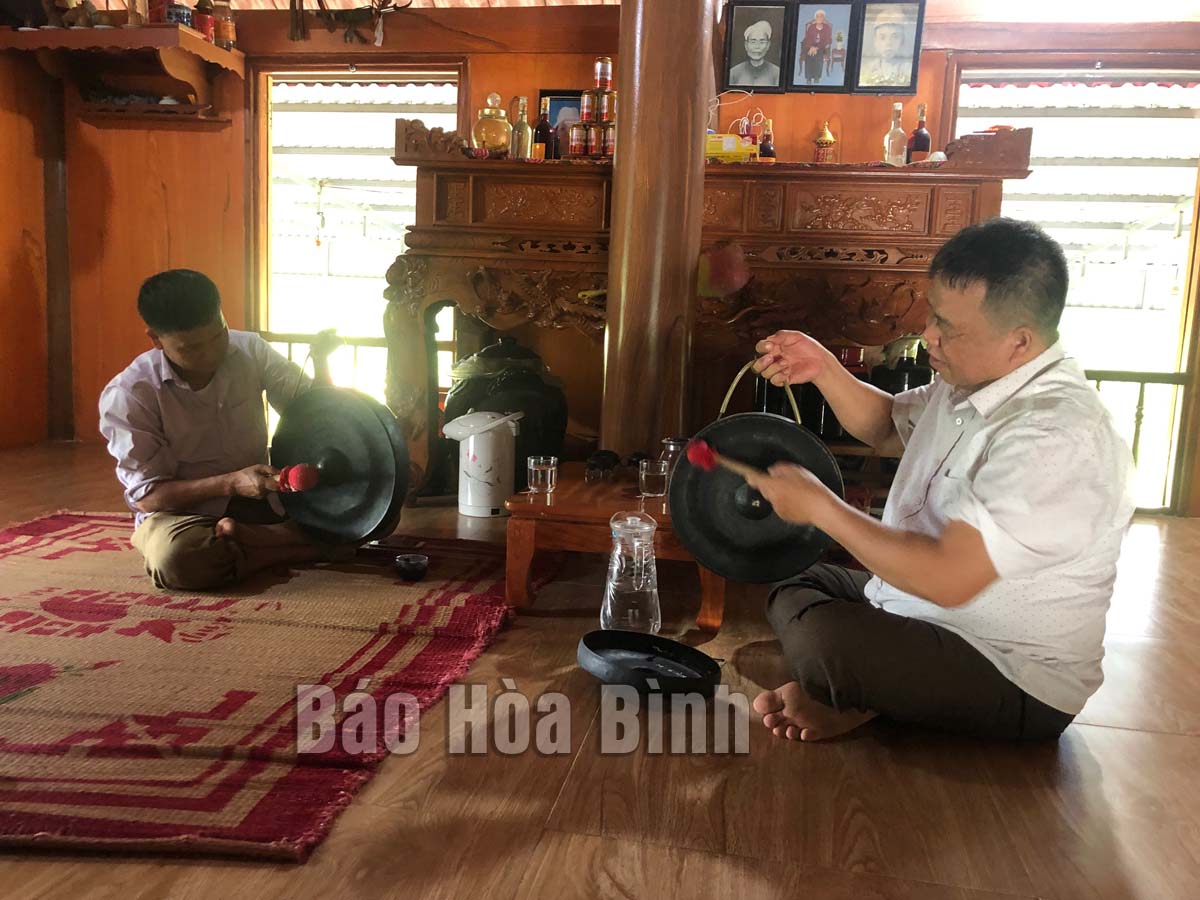


(HBO) - Returning to My Hoa (Tan Lac) today, the local economy is on the rise, the people's lives have been flourishing.

Gongs in My Hoa commune.
In addition to the spacious 2-storey houses, the life with many modern and comfortable equipment, many stilt houses with the traditional beauty of the Muong people are still preserved and cherished by the local people. That has proved the intense vitality of Muong cultural flow that is being preserved and conserved by the people of Muong Bi Mr. Bui Van Hung, Mo Muong artisian, from Chu Bua hamlet, My Hoa commune (Tan Lac) often introduces Muong gongs whenever there are precious guests visiting his house.
Walking on a concrete road in the middle of a green purple sugarcane field with Mr. Dinh Hoai Khoa, a cultural and sports officer of My Hoa commune, we visited the house of Mo Muong artisan, Mr. Bui Van Hung in Chu Bua hamlet. The solidly built house is designed and painted according to the architecture of the traditional stilt house, with columns, the under floor, the stairs and the windows. Stepping by the stairs to the main room of the house, besides the tools for Mo practice passed down by the forefathers such as Khot bags, the bells, the spears there is a set of Muong gongs in the most solemn position of the house, which is hung neatly in order from the large one to small one. According to Mr. Hung, he like many other Muong families in My Hoa commune, always tries to preserve the unique features of the national identity, trying not to let that beauty fade over the time. The selective inheritance and the promotion of traditional beauty are what he always want to teach his children and grandchildren.
Currently, there is about 40% of families in My Hoa commune, still keep their traditional stilt houses. In each house, the people still keep the traditions and customs such as wearing the national costumes on the occation of holidays, Tet, speaking the language of Muong ethnic people, and eating betel nut. Any house with women and girls must have at least one Muong dress with skirts, top shirts, green scarves, and sarongs to wear on important occasions of the year. The dishes in Muong cuisine such as sticky rice, steammed wild vegetables, grilled fish, and chicken cooked with sour bamboo shoots have been restored by the local people, which has become an indispensable dish in the tray of rice dishes or daily meals. In addition, the customs in funerals and weddings continue to be maintained and simplified according to the new cultural lifestyle. In My Hoa, there are still over 160 gongs of all kinds, many of which are the ancient bronze gongs wth hundreds of years old. Each hamlet maintains a ward of talismans that regularly perform on holidays, Tet, the national unity-day or the important occasions. The commune also has a Mo Muong club with 31 members, including 10 skilled artisans.
Sharing with us about the cultural features that My Hoa still preserves, Mr. Dinh Hoai Khoa says: The pride in My Hoa is that there are many elderly people who understand Muong culture and the younger generation respects it, and they are infatuated with it. On nights when there is moon and it is windy or when the farmers are free, many people in and out of the commune often go to the house of the elite artist, Mr. Dinh Cong Tinh in Don hamlet to learn to play the flute, to sing Doi, Vi, Bat Am and and Mo. The class is spontaneous, and the students are of all ages, from elementary school children to gray-haired grandparents. There, those who know teach those who don't know, and those who are good teach those who are not. So far, most of the young people in the commune have known at least some basic Muong folk songs such as Moi Trau, beating cotton and many Vi singing tunes. Others know how to play the gong, play the flute, and pull the trigger.
In order to contribute to preserving and conserving the national cultural identity, the Party Committee and the Communal People's Committee have focussed on propagating and encouraging the people to restore the traditional knitting and brocade weaving. They have creating conditions for the people to buy, sell and exchange Muong gongs to enrich the number of gongs in each family, and respectfully preserve and conserve the ancient bronze gongs. They have also been promoting the preservation of the traditional customs, teaching folk songs, musical instruments and Mo Muong to the younger generation so that the can be the traditional values can be preserved, promoted and reflected in each of the eating habits, clothes and activities of each family and individual in the community.